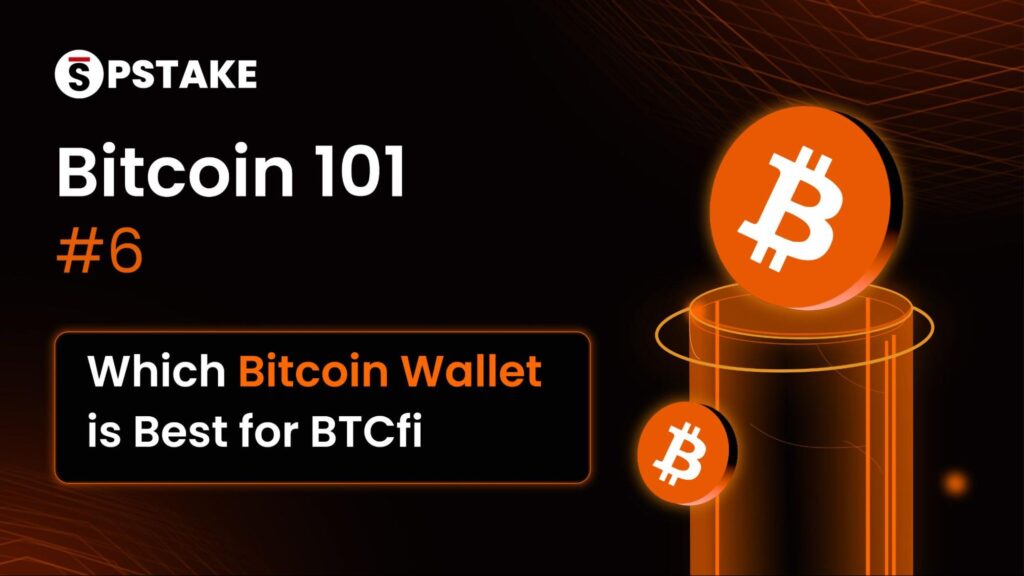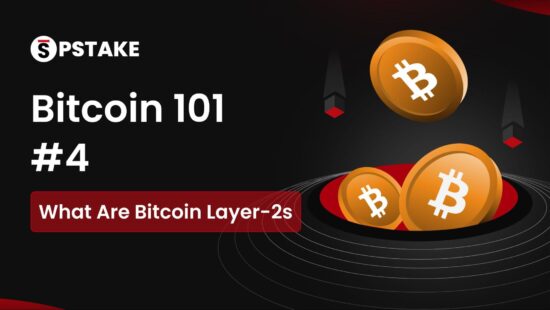With pStake Finance moving into the heart of the Bitcoin ecosystem on its mission to provide native Bitcoin yields to holders, we’ve crafted this Bitcoin 101 series to help newcomers understand the number-one-ranked cryptocurrency slightly better.
With thousands of articles relating to Bitcoin available online, we hope our series can condense the complex information, demystify the confusing jargon, and provide an insightful overview of the granddaddy of the crypto world.
In our first entry, we introduced you to the basics of Bitcoin, the pioneering digital currency that has revolutionized how we perceive and interact with money in the digital age. Then, we continued to overview the Proof-of-work (PoW) consensus algorithm that powers the Bitcoin network’s security.
The third entry covered everything you needed to know about blockchain technology.
With all the basics out of the way, it’s time to delve deeper into Bitcoin. Today, we would like to overview what Bitcoin layer-2 networks are by covering what they do and why they’re necessary. Although Layer-2s have been a staple of Ethereum for several years, the concept is just getting started on Bitcoin.
So, grab a sandwich and top up that bevy as you prepare to continue binge-reading through this series about Bitcoin.
What Are Layer-2s
Despite Bitcoin’s revolutionary technology, it’s important to understand some of the challenges it has faced over its short, decade-long lifespan. The most prominent challenges relate to scalability and composability.
You see, although Bitcoin was a groundbreaking first-mover into the blockchain world (it created blockchain—read this if you need to learn more), its position of being a first-to-market meant that its codebase implementation had limitations.
As a result, the Bitcoin blockchain has been known to experience slow transaction times, charge high transaction fees under heavy loads, and lack integration into other ecosystems.
This is what Layer-2s intend to change.
So, we can define a Layer 2 as the following:
“A solution that’s built on top of the Bitcoin blockchain that seeks to provide enhanced scalability or composability for Bitcoin on a separate layer.”
Again, let’s break this down into its simplest form.
A solution that’s built on top of the Bitcoin blockchain…
Layer 2s are solutions that are built on top of the Bitcoin blockchain. They might have connections with the main chain at specific points, but they’re classified as independent entities that run parallel to the Bitcoin blockchain.
…that seeks to provide enhanced scalability…
One solution that Layer 2s are attempting to provide is enhanced scalability. This means they seek to reduce transaction costs while helping Bitcoin facilitate more transactions on its network.
…or composability…
Composability, in the context of Layer-2s, refers to the ability of other systems to integrate with it. In this case, it means that Layer-2s are trying to bring programmability to the Bitcoin blockchain, allowing decentralized applications to be built on top of it.
…on a separate layer.
This simply reiterates that Layer 2s are built on top of the Bitcoin main layer as a separate, completely independent layer.
Why Are Layer-2s Necessary?
As mentioned, Bitcoin faces inherent limitations due to its block size and transaction throughput. Each block, roughly 1MB (theoretically 4MB) in size, can only process a limited number of transactions approximately every ten minutes. As Bitcoin gained popularity, high transaction fees and slow confirmation times became significant issues. Users often have to wait longer for their transactions to be confirmed and pay significantly higher fees, especially during high network congestion.
So, to handle more transactions and keep costs low, Bitcoin needs a solution to help it scale without compromising its impressive decentralization and security.
This is where Layer-2 solutions step in, offering a promising path forward for Bitcoin, addressing its inherent limitations and paving the way for a more scalable and efficient future.
In addition to the scalability issue, Layer-2s also help to bring programmability to Bitcoin.
How Do Layer-2s Work?
There are dozens of Layer-2 protocols, each with their own implementation. However, the general idea involves Layer-2s facilitating off-chain transactions away from the Bitcoin blockchain to reduce its workload.
After processing transactions off-chain, the Layer-2 reports back to the Bitcoin blockchain in batches, allowing them to be recorded on Bitcoin to leverage its elite verification protocol. This approach differs from other scaling solutions, such as increasing the block size or reducing the block time on the main chain, which can compromise decentralization and security.
The most crucial part to understand is that Layer-2s run separately from the main Bitcoin blockchain. As a result, they can handle more transactions than the seven transactions per second that the main chain can handle. Even more importantly, Layer-2 chains can introduce their own codebase, bringing programmability to Bitcoin that allows projects to finally build applications on the world’s most powerful blockchain.
Bitcoin Layer-2s Today
The Bitcoin Layer-2 revolution began with the Taproot upgrade in 2021, which expanded the amount of data that a Bitcoin transaction could store. Without getting too technical, Taproot allowed advanced scripting in the Witness section of a block and removed data limits between two sections of a block, allowing up to 4MB of data into the Witness section.
Put simply, this opened the doors for a new wave of building on Bitcoin as more data could be encoded onto the blockchain through the added memory capacity.
What happened next was a surge of activity of building on Bitcoin, best shown through the following diagram from Binance Research:

Here’s a quick rundown of some of the popular types of Layer-2s that are being built;
State Channels
- Allows users to create payment channels between two parties on that channel.
- Transactions occur off-chain, with initial and final balances recorded on the main chain.
- Provides near-instant transactions with low fees.
- Great for microtransactions.
- NOTE: State Channels can be used for any state transfer, introducing more functionality to Bitcoin such as gaming and real world assets (RWA).
Sidechains
- Distinct blockchains that are attached to the main chain.
- Allow developers to experiment with different blockchain rules, block sizes, and consensus mechanisms.
- Transactions can occur between the sidechain and the main chain.
- Allows for programmability to build applications on top of the chain.
Let’s take a deeper look at some of the projects that are building these types of Layer-2s:
| Name | Website | Description | EVM Compatible? |
| BEVM | https://www.bevm.io/ | BEVM provides a better experience, using Web3 principles to advance Bitcoin ecosystem application development to the next level | Yes |
| Elastos | https://elastos.info/ | Enabling private digital identity, powered by Bitcoin. | No |
| Rootstock | https://rootstock.io/ | Allowing users to build on Bitcoin, secured by PoW | Yes |
| Stacks | https://www.stacks.co/ | The leading Bitcoin L2 to use and build apps that use Bitcoin as a security base layer | No |
| B2 Network | https://www.bsquared.network/ | Creating a modular design to scale Bitcoin. | Yes |
| BOB | https://www.gobob.xyz/ | Helping developers build everything on Bitcoin using the versatility of Ethereum. | Yes |
| Lightning Network | https://lightning.network/ | Using payment channels to provide lightning-fast BTC transactions. | No |
| Liquid Network | https://liquid.net/ | A Bitcoin layer-2 solution enabling the fast, confidential settlement and issuance of digital assets, including stablecoins, security tokens, and other financial instruments. | No |
To learn more about Bitcoin Layer-2s being developed today, the following links serve as great resources:
https://docs.google.com/spreadsheets/d/1UuNPwG_1P1p2f9mQcaBa6qRcrosiUrGhV0oaQcazENk/edit#gid=0
https://www.binance.com/en/research/analysis/the-future-of-bitcoin-3-scaling-bitcoin
The Future of Layer-2s
As we are very early in the development of Layer-2s, it’s important to recognize that most are sidechains that don’t adopt the BTC economic security model. However, it’s also important to recognize that Bitcoin is sitting where Ethereum was in 2018. It took five to six years to scale Ethereum to where it is today, and it’s just getting started for Bitcoin.
As Bitcoin continues to evolve, the potential of Layer-2 technologies is immense for its long-term success and scalability. Innovations in Layer-2 solutions continue to emerge, promising more efficient, flexible, and secure ways to handle transactions off the main blockchain. Best of all, they introduce concepts that have been longed for by BTC holders, such as native yield, painting a bright future for Bitcoin’s usability and capital efficiency.
In addition, Layer-2 solutions are pivotal in addressing Bitcoin’s scalability challenges. By ensuring faster transactions at lower costs, they help make Bitcoin a more widely used currency. With the ongoing advancements and increased adoption of Layer-2s, the innovative technology holds the key to Bitcoin’s future.










